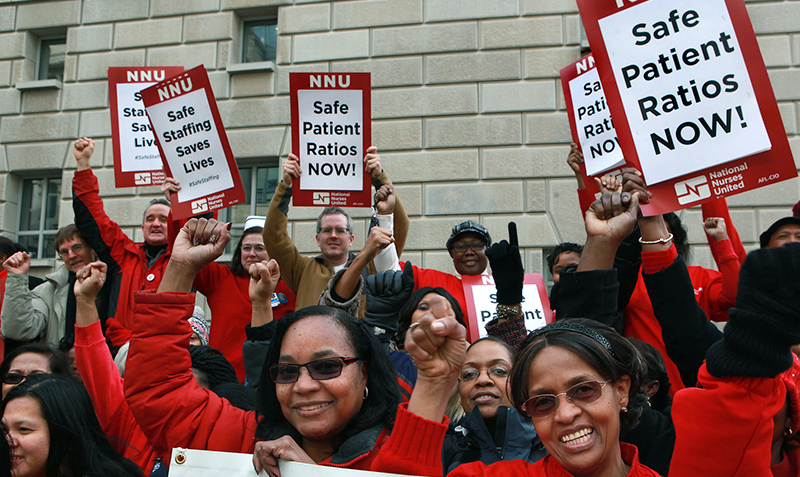Nurse-to-patient ratios have been a key performance indicator for hospitals for years. If there are too many patients on the floor without enough providers, health and performance outcomes can suffer. Nurses must limit their time with each patient as they try to care for multiple individuals at once. Low nurse to patient ratio numbers can also lead to staff burnout, depression, and high turnover rates as facilities push providers to the breaking point.
The COVID-19 pandemic is casting a new light on these ratios and how they affect both providers and patients. Nurses in New York are championing legislation that would increase the number of providers on the floor across the state, but industry experts say these requirements would essentially bankrupt struggling facilities.
Find out how this debate is heating up across the country.
The Math Behind Nurse-to-Patient Ratios
Researchers have been studying the effects of different nurse to patient ratios for years. Statistics show that putting more providers on the floor can be beneficial in more ways than one.
According to the Journal of the American Medical Association, going from a 1:8 nurse-patient ratio to 1:4 can make all the difference in the world. Hospitals with 1:8 ratios experience five additional deaths per 1,000 patients than those with 1:4 ratios.
A 1:8 ratio means every nurse is responsible for up to 8 patients at a time, so they need to do twice the amount of work as those working in a facility with a nurse-to-patient ratio of 1:4. Furthermore, the odds of patient death increases by 7% for each additional patient the nurse must take on at one time. Safe staffing ratios also lead to increased patient satisfaction in the nursing unit, along with fewer medical errors made by overstretched health care professionals.
Nurse-Patient Ratio Laws by State
In most states, facilities have the power to set their own nurse-to-patient staffing ratios. Fourteen states have passed what are known as Safe Staffing Laws, but in 13 of these states, the law only requires facilities to come up with a plan for managing these nurse staffing levels. It does not regulate how many providers should be on the floor.
The only exception is California, which became the only state to pass sweeping regulations in 2004. Under the law, facilities must have at least one nurse for every 5 patients on average in medical-surgical units, and one nurse for every two patients in ICUs.
NY Nurses Fight for Safe Staffing Ratios
Now, nursing staff members in New York are following in California nurses’ footsteps.
The legislation, which is currently under review, would require facilities to increase the number of providers on the floor, including at least one nurse for every two patients in the ICU. If passed, it could have major implications for the state’s healthcare infrastructure.
Providers up and down the state are hoping to enact such legislation before what they see as a possible second wave of COVID-19. New York City was ravaged by the pandemic when it first hit the U.S. back in March. Now, nurses are doing everything they can to prevent such an event from happening again.
Nurses and their advocates say having such a law in the books at the height of the pandemic could have helped save thousands of lives. Pat Kane, the leader of a nurse union supporting the legislation, says, “If we had better staffing in place before COVID-19, if we weren’t stretched so thin, we would have been able to handle the flex and surge that was required.”
However, some say that having such a law in place at the start of the pandemic wouldn’t have made much of a difference. Many nurses and frontline workers were falling ill at the time due to a lack of PPE. Extra staff members could have increased the demand for live-saving face masks, gloves, and other essential safety equipment. The state also brought in thousands of registered nurses and other providers from all over the country, but many arrived several weeks into the crisis.
What About Cost?
The debate over nurse-to-patient ratios almost always leads to the issue of cost. Hiring more providers costs a lot of money, which could put some facilities in the red.
A new report from the New York health department shows that enacting this new legislation would force nursing homes and hospitals to hire a combined additional 35,000 nurses, which would cost somewhere around $4 billion.
Industry leaders say this is simply out of the question, especially when so many facilities are at risk of losing revenue.
Kenneth Raske, President of the Greater New York Hospital Association, recently told reporters, “During the crisis, the increased costs would have been unbearable, coming on top of the extremely expensive surge costs front line hospitals incurred. Now, in the COVID-19 transition era, when hospitals are fighting for their very survival due to a severe loss of revenue, such a mandate is unthinkable.”
However, nursing advocates are quick to shut down this argument. Studies have shown that increasing the number of providers on the floor can actually be good for business. After ratios were implemented in California, hospital income rose dramatically from $12.5 billion to more than $20.6 billion. Managers also say that increasing nurse-to-patient ratios makes it easy to apply for funding.
Safe nurse-to-patient ratios also reduce turnover rates, so facilities don’t have to spend as much money on hiring, recruiting, and training.
It’s also important to note that hospitals in California still retain the flexibility to assign fewer nurses to patients and wards if it’s considered appropriate.
Kane argues that legislators and industry experts should listen to nurses that are putting themselves at risk every single day. “It’s one thing to say they’re heroes and they made the sacrifice. But listen to them, and that will show them you really mean that…Because they dread the idea, they can’t imagine going through something like that again.”
Every facility is different; and hospitals are in danger of losing billions of dollars in revenue as the pandemic stretches on, but that doesn’t mean that higher nurse:patient ratios should be off the table. Facilities should consider increasing the number of providers on the floor as they prepare for what could be a devastating winter.


















